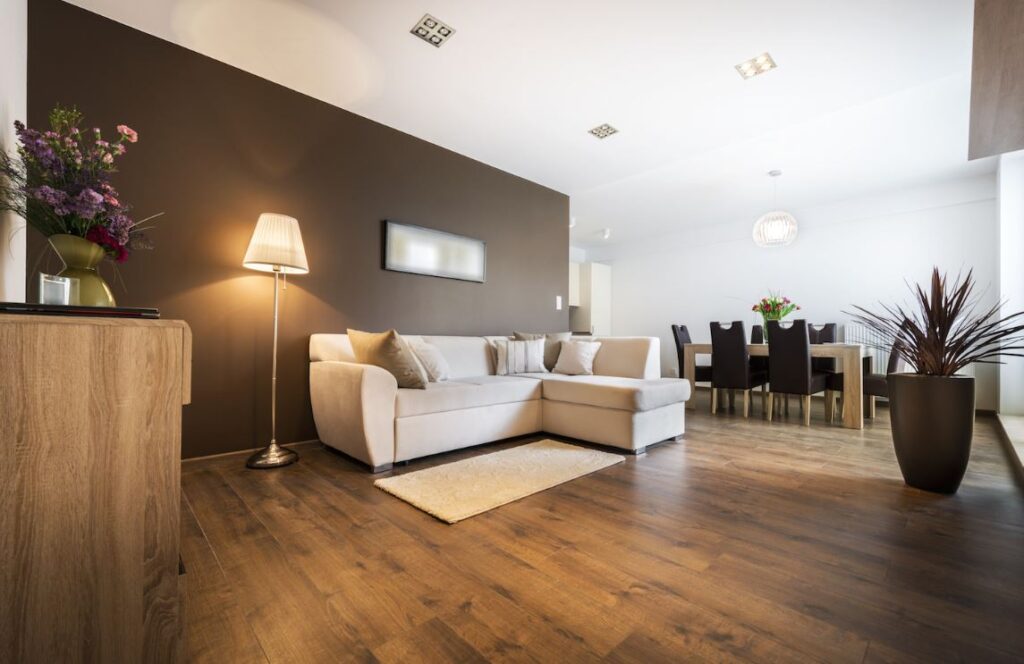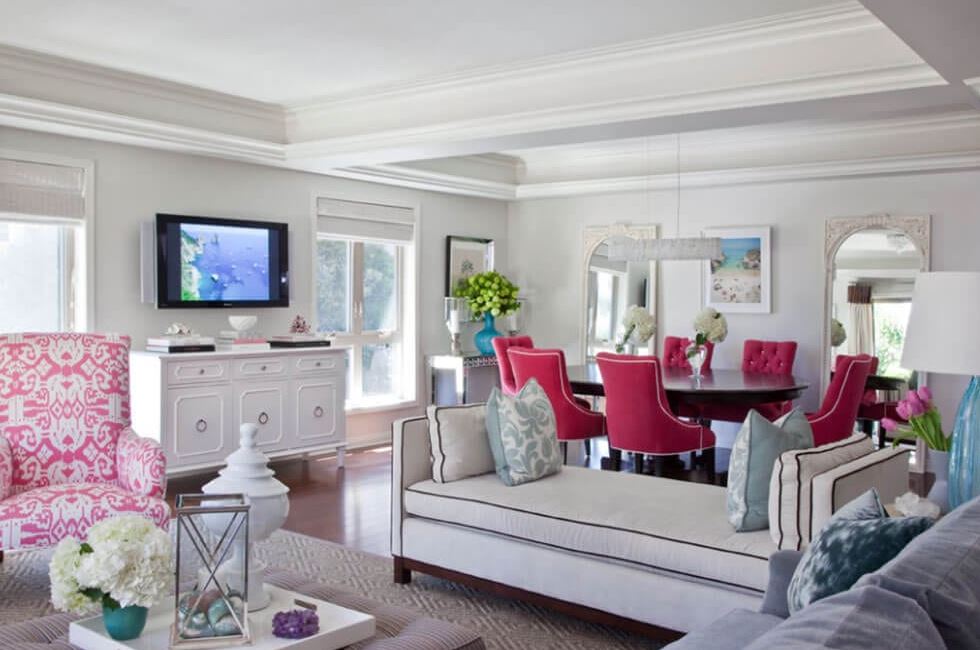Open-concept homes have become increasingly popular over the years, lauded for their spaciousness and unity in a living environment. These designs, which often combine the kitchen, dining, and living room into a single, large space, allow for greater interaction among family members and make entertaining a breeze. However, creating a harmonious flow in an open-concept space can be challenging. With different zones serving different functions, it’s easy to end up with a jarring mishmash of colours and styles that feels more chaotic than cohesive.
Enter the transformative power of paint. A well-chosen colour scheme can define different areas within an open space and connect them in a harmonious flow, making the home feel unified yet diverse.
In this blog post, we’ll explore the challenges of decorating open-concept spaces and delve into paint’s role in solving them. From the psychology of colours to practical painting techniques, we’ll provide you with a comprehensive guide to using paint to create a seamlessly connected living space.

So, grab your colour swatches and put on your creative cap; it’s time to paint your way to a perfectly flowing open-concept home.
The Challenge of Open-Concept Spaces
One of the first hurdles homeowners face when dealing with open-concept spaces is inconsistency in design. When multiple ‘rooms’ or zones—like the kitchen, dining area, and living room—coexist within one larger space, there’s a risk of creating disjointed aesthetics if not carefully planned. For instance, a modern, minimalistic kitchen might clash with a living area that leans towards vintage, rustic decor. Not only can these inconsistencies become eyesores, but they can also create a sense of confusion and imbalance. Since there are no walls to define different areas clearly, your design elements must do the heavy lifting. A lack of design consistency can make an open-concept home feel like a fragmented jigsaw puzzle where the pieces don’t fit together.
Another area for improvement is the loss of distinctiveness for individual spaces. Since open-concept designs meld multiple spaces into one, the individual identity of each area can be at risk. For example, you might feel like your kitchen has invaded your living room, or vice versa, especially if colours, textures, or furniture styles don’t differentiate one space from the other. Not having clearly defined zones can make your living area feel like one large, undefined blob, losing the individual characteristics that make each space unique and functional in its own right.
The Power of Colour Theory
Before diving into colour choices, it’s essential to consider the psychological impact that colours can have. Different hues evoke different emotions and moods, which can be leveraged to add depth and emotion to your living spaces. For instance, blues are calming and serene, making them ideal for spaces where relaxation is the primary goal, like the living room or bedroom. On the other hand, energetic colours like red or orange can make a space feel lively and dynamic, suitable for areas like the kitchen where activity is high. Understanding the psychological influence of colour can help you pick the perfect palette to achieve the mood you want for each zone in your open-concept space.
Once you’ve decided on the moods you want to evoke in different zones, the next step is to create a cohesive colour palette that connects these areas while maintaining their individuality. Start with a base colour that reflects the overall tone you want for your home; it could be a neutral like beige or a more vibrant hue that reflects your personality. Next, select complementary or analogous colours that can serve as secondary and tertiary hues for different zones. The trick is choosing colours that can work well together in various combinations, offering enough contrast to restrict different areas while creating a sense of unity.
For instance, if you’ve chosen a warm, beige colour as your base, consider using earth tones like rust for the dining area and a soothing sage green for the living area. These colours complement each other well and can be connected smoothly through shared accents, like cushions or artwork that incorporate all the selected colours.
Remember that too much of a good thing can be overwhelming even as you play with colours. This is where neutrals come in handy. Shades like white, grey, and beige are versatile and can counterbalance more vibrant colours. You can use neutrals for larger surfaces like walls and ceilings and reserve bolder hues for accent walls or furniture. This creates a sense of balance and continuity, ensuring that the eye moves smoothly from one zone to the next without experiencing visual fatigue.
Neutrals are also great for transitional spaces, such as hallways or the areas right between two distinct zones. They can serve as a palate cleanser, allowing the eye to adjust before moving from one area to another. For example, if your kitchen is a lively yellow and your living room is a calming blue, a neutral transition zone can help these contrasting spaces blend more harmoniously.
Techniques for Painting Open-Concept Homes
One effective method to create visually distinct zones while maintaining a harmonious look is through zonal painting. You can restrict spaces without physical barriers by using varying shades of a selected palette or even contrasting colours that complement each other. For example, if your base colour is a soft beige, the kitchen could be painted in a slightly darker or lighter variation of that hue to separate it from the dining and living areas. This allows each space to maintain its unique identity while still being part of a cohesive design.

Accent walls can serve as powerful tools in linking spaces visually. You create a focal point that draws the eye by choosing one wall to paint in a bold, contrasting colour or pattern. This can be particularly effective in open-concept designs where an accent wall in the dining area, for example, can be seen from both the kitchen and living room, creating a sense of unity among all three spaces.
Colour gradients or complementary colours can work wonders in easing transitions between zones. Consider painting transitional spaces—areas that serve as connectors—either in a gradient that moves from one dominant zone colour to another or in a neutral hue that complements both adjacent spaces. For instance, if one zone is blue and another is green, a transitional space might incorporate a gradient blending the two, or it might be painted in a neutral grey that harmonises with both.
For those who prefer a simpler, more streamlined look, a monochromatic colour scheme can also work well in open-concept homes. You can create subtle distinctions between different areas by using varying shades of a single colour. Lighter shades can open up a space, making it feel larger, while darker shades can make it feel cosier and more intimate.
Visit the website to hire professional painters or get advice.
Practical Tips for Implementing Your Paint Strategy
Before committing to a colour scheme, testing out paint swatches on your walls is wise. This allows you to see how different colours interact with natural and artificial light at various times of the day. What looks like a soft beige in the morning might appear too yellow under your evening lighting.
Various apps and software allow you to upload photos of your space and virtually “paint” them in different colours. While not a substitute for seeing paint in the physical space, these tools can give you a good initial sense of how your chosen colours will look.
If you’re struggling with your colour choices, consulting with a professional interior designer specialising in colour theory may be beneficial. They can offer valuable insights and recommendations tailored to your home and personal tastes.
Paint isn’t just about adding colour to walls; it’s a powerful design tool that enhances and defines your open-concept home. From zonal painting to accent walls, the techniques discussed in this blog post offer various ways to create a sense of flow and unity, making your home feel expansive and cohesive. As you embark on your painting project, remember to test out your choices with swatches, use digital tools for preliminary visualisations, and don’t hesitate to consult professionals for expert advice.
So go ahead, pick up that paintbrush and let your creativity flow! Tailor these ideas to suit your unique home, and the challenges of an open-concept design can become opportunities for stylistic expression. Your home is your canvas—make it a masterpiece.